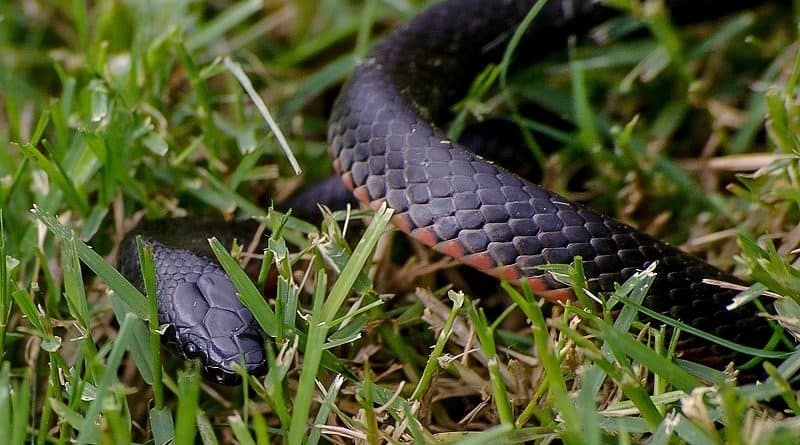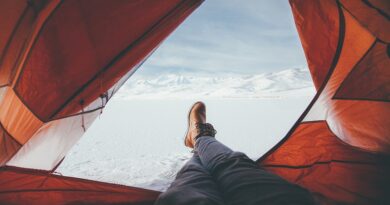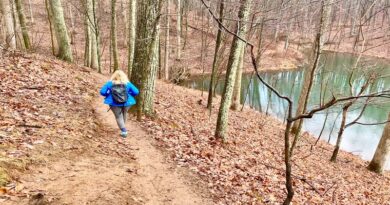Need to Know: Where Do Snakes Go in the Winter?
I’ve been fortunate to have seen very few snakes on the hiking trails. As the weather has cooled, however, I am curious. Where do snakes go in the winter?
I never see snakes on the trails in the fall and winter months. Do they hibernate like bears? Is there a “snake season?” I have so many questions.
There are 32 species of snakes that are native to Virginia. Harmless snakes include rat snakes, garter snakes, water snakes and black snakes.
Virginia is also home to poisonous snakes, including copperheads, rattlesnakes and cottonmouths. None are aggressive, not even the venomous snakes.
Still, I’m not exactly eager for a snake to cross my path on the trails. For this reason, I wanted to share what to know about snakes and winter hiking.
Do Snakes Hibernate in the Winter?
Let me first address what we all want to know: do snakes hibernate in the winter? They do, but among reptiles, this inactive state is called brumation.
Snakes are cold-blooded animals. This means that as the temperature drops, they become sluggish and lethargic, much like humans do when we get very warm.
Typically, snakes become less active when temperatures dip below 60 degrees Fahrenheit. To survive, snakes often look for snug, safe burrows to keep warm.
Where do Snakes Hibernate?
Snakes may seek out cold weather shelters in caves or holes, under rocks or logs, in tree hollows or underground. They may also shelter in a hibernaculum.
A snake hibernaculum is an underground den beneath the frost line where multiple dormant snakes can go to protect themselves from cold temperatures.
Inside a hibernaculum, snakes of the same and different species may coil themselves together to achieve a minimum internal body temperature for survival.
Gathering together in a safe place with other snakes in the coldest months of the year also helps these cold-blooded reptiles retain moisture.
When Do Snakes Hibernate?
In Virginia, snakes brumate from late fall to early spring. However, the length of this long winter sleep will depend on the outside temperature.
To be clear, snakes are not in a deep sleep this entire time. They are simply less active. Mild winters can also shorten the snake hibernation period.
In fact, it would not be entirely uncommon to see a single snake sunning himself on a warm winter day to help raise his own body temperature.
How Do Snakes Get Ready for Winter?
While we are busy ogling colorful foliage in the fall, snakes are busy looking for winter shelters and fattening themselves up before hibernation.
If you felt like you saw more snakes in early fall, that’s because snakes have been working on overdrive in search of food sources and winter burrows.
In winter, their body temperatures are too low to digest food. They do not eat during brumation and must increase their body fat ahead of the dormant season.
As winter nears, their metabolic rate drops significantly. Snakes consume little energy and will go for a long time without sustenance.
What Do Snakes Eat in the Winter?
Snakes do not eat in the winter. Instead, these carnivorous reptiles enjoy a hearty buffet of mice, frogs, toads, insects, eggs and worms in the fall.
Snakes eat and swallow their food whole. An expandable jaw enables them to eat prey that is larger than them, even small birds and small animals.
In cold winter months, snakes are unable to process and digest food items because their body temperatures are simply too low.
Snakes may, however, leave their winter dens every so often for a drink of water to stay hydrated. In a state of brumation, they are less active, not inactive.
When Do Snakes Come Out of Hibernation?
We all want to know where snakes go in the winter, but we also want to know when they will re-appear on our trails. Essentially, when is snake season?
In Virginia, snakes are active from April to October. This is true for nearly all of North America. However, once a snake’s body warms, he can be active.
Snakes rely on chemical reactions within their bodies. These reactions peak between 70 to 90 degrees. This is when snakes are most active on the trails.
On warm days, following a lengthy cold spell, you may see snakes on the trails, so be sure to stay alert as you hike in warmer weather.
Will I Ever See Snakes in the Snow?
I love to hike on snow-covered trails, but not to worry, you won’t see a white “snow snake.” They simply could not survive in winter temperatures.
Social media posts have described deadly “snow snakes” that come out in cold weather. Their bites are said to cause a victim’s blood to freeze.
Thankfully, there is no such thing as a “snow snake,” according to this Reuters article. Snakes are not active in winter and are certainly not looking to bite.
In winter, a snake may stir now and again, maybe to seek out water to re-hydrate. They will then return to their hibernaculum to re-warm themselves.
How Do I Avoid Snakes While Hiking?
As I noted above, it’s highly unlikely that you will encounter a snake while on the hiking trails. They are typically burrowed away from October to March.
However, if you’re still unsure, it’s a good idea to use trekking poles or a walking stick while you hike in warm weather.
Snakes avoid predators, such as humans. Unless they feel threatened, that is. When hiking poles or a walking stick hit ground level, they cause vibrations.
These vibrations alert snakes to your presence. It lets them know you are in the area so they can stay out of your way while you are on the hiking trails.

Erin Gifford has completed more than 300 hikes in Virginia. She is also the author of three hiking guidebooks from Falcon Guides. Need help finding a hike? Check out the Trail Finder feature or send Erin an email at [email protected].




